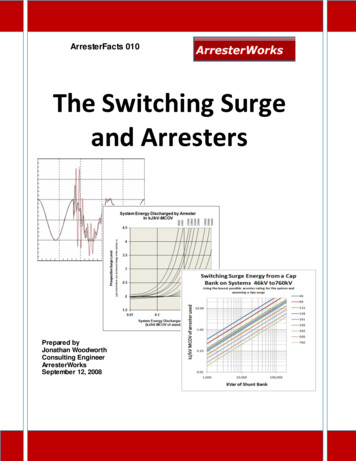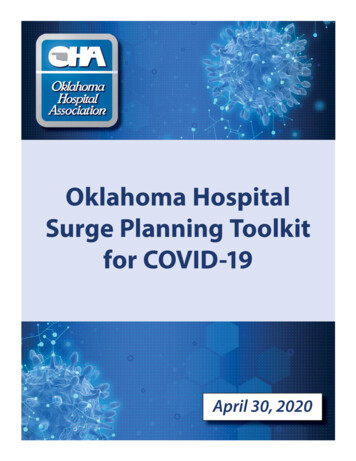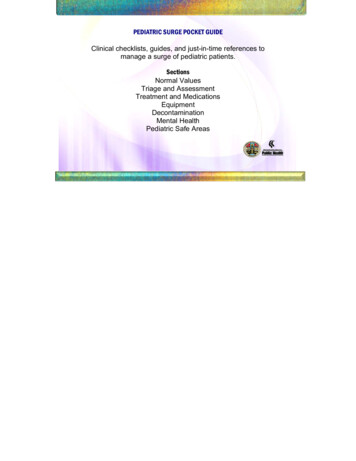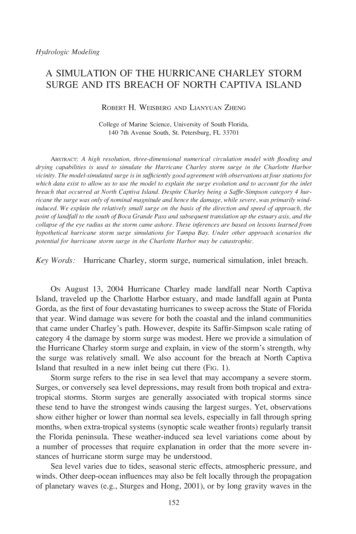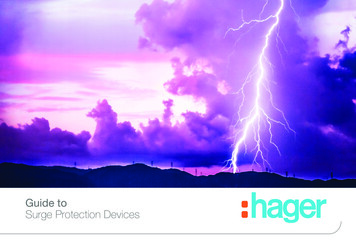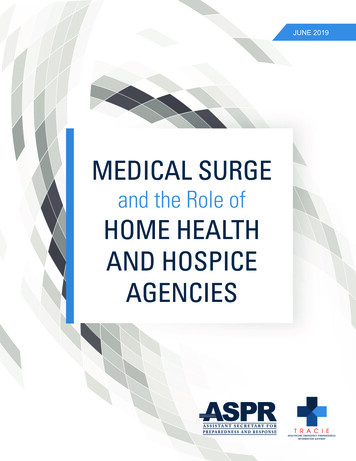
Transcription
JUNE 2019MEDICAL SURGEand the Role ofHOME HEALTHAND HOSPICEAGENCIES
CONTENTSExecutive Summary 3Background 5Methodology 6Findings 8Recommendations 26Limitations 28Conclusion 28Appendix A: ASPR TRACIE Home Health and Hospice Survey 29Appendix B: ASPR TRACIE Home Health and Hospice Interview Discussion Guide 36Appendix C: Helpful Preparedness and Response Resources for Home Health Care andHospice Agencies 39Acknowledgments 442Medical Surge and the Role of Home Health and Hospice Agencies
EXECUTIVE SUMMARYOverviewMillions of patients across the country receive care through Medicare-certified home health agencies and hospices eachyear. Mostly comprised of older adults who frequently have multiple medical conditions and often have lower householdincomes, home health and hospice patients are among the most vulnerable populations in the U.S. Unlike other recipients ofhealthcare services, the care is delivered to the home health or hospice patient; the patient does not travel to receive care.Emergency planning for home health and hospice agencies must account for a continually changing patient population andcare setting; unique situations encountered in each care setting; the routes staff must travel to safely and efficiently reachtheir patients; and the business continuity of their administrative offices.To ensure that healthcare providers are equipped and prepared to effectively respond to emergency situations, the Centersfor Medicare and Medicaid Services (CMS) issued the Emergency Preparedness Requirements for Medicare and MedicaidParticipating Providers and Suppliers Final Rule (the CMS Final Rule) in November 2016.1 Home health agencies andhospices are among the 17 provider and supplier types subject to this Rule. ASPR TRACIE conducted this exploratory studyto learn more about the implementation of emergency management activities in Medicare-certified home health care andhospice agencies. While other vital services are delivered in the home, including those supporting activities of daily living,this study focused on the delivery of healthcare services.MethodsThe U.S. Department of Health and Human Services, Office of the Assistant Secretary for Preparedness and Response(ASPR) Technical Resources, Assistance Center, and Information Exchange (TRACIE) conducted 245 online surveys with homehealth and hospice agency leaders from 43 states to collect their perceptions about the role of Medicare-certified homehealth and hospice agencies in supporting the health and medical response to disasters or emergencies. †Among theseagency leaders, 25 participated in one-on-one in-depth telephone interviews and provided additional detail on their surveyresponses. The survey and follow-up interviews sought to assess Medicare-certified home health and hospice agencies’:(1) characteristics, (2) role in emergency response, (3) emergency response infrastructure, (4) emergency preparednessprocedures and collaborations, and (5) emergency preparedness barriers. Findings from this study will be used to increaseawareness of home health and hospice agencies’ potential emergency healthcare response capabilities and to addresssome of their identified technical assistance needs.Key FindingsBased on the survey and interview data, ASPR TRACIE identified the following key findings:»Home health and hospice agencies have an essential role in addressing healthcare needs during emergencies anddisasters, however, their perceived role varies greatly and has not been clearly defined at the local, regional, state, orfederal level.The level of capability and infrastructure for emergency response significantly differs among home health and hospiceagencies. Some agencies report having a limited response capacity, particularly those located in rural areas andthose that have less established partnerships and collaborations with local emergency response partners and otherhealthcare providers.The survey and interviews were conducted in accordance with the Paperwork Reduction Act under Office of Management and Budget ControlNumber 0990-0379, approved February 1, 2019. ICF’s IRB reviewed and determined the project was exempt from IRB review on January 18, 2019.†3Medical Surge and the Role of Home Health and Hospice Agencies
»Most respondents indicated their agencies have an emergency response plan, train their staff and patients onemergency preparedness, and test their emergency response procedures. More than two-thirds of respondents reportedparticipating in coordinated emergency preparedness activities with healthcare coalitions and a majority coordinatedwith emergency management agencies, hospitals, public health departments, and nursing home or long-term careacilities. However, many also noted these collaborations to be challenging.Fewer than half of the survey respondents indicated their agency was part of an integrated healthcare system. Amonghose who are part of an integrated healthcare system, most participated in that system’s development of its emergencypreparedness program, suggesting a greater awareness of capabilities and engagement across the system.Home health and hospice agencies often encounter important challenges to effective involvement in an emergencyesponse, including: lack of time and resources; being unsure of the role or not engaged in community planning foremergency response; continually changing patient population/care setting; and difficulty collaborating and engagingwith local, regional, and state preparedness partners.With the significant differences in the resources, services, and preparedness levels among the Medicare-certified homehealth and hospice agencies associated with this study, the survey data and insights shared by the interview participantssuggest that opportunities exist to improve home health and hospice agencies’ emergency response. ASPR TRACIErecommends that this could be accomplished by:»Clearly defining the role of home health and hospice agencies in emergency response at different levels including local,state, and federal.Promoting active involvement of home health and hospice agencies in local healthcare coalitions and engagement withother provider-type members (e.g., hospitals, adult homes, and nursing homes).Developing tailored training strategies and technical assistance to increase emergency management knowledge andcapacity among home health and hospice agencies.Providing emergency management resources and support to home health and hospice agencies.Coordinating emergency response communication with facilities in which hospice agencies provide care to ensure thecare of their patients.Facilitating and promoting mechanisms for communication, collaboration, and networking related to emergencymanagement issues among home health and hospice agencies.This study does not provide conclusive statements on emergency management that are generalizable to all Medicarecertified home health and hospice agencies. Rather, the project team used this exploratory study to learn more about therole of home health and hospice agencies in emergency response and to inform future efforts from ASPR TRACIE. Thesefindings and recommendations are a first step toward greater emergency management awareness and engagement,particularly among home health and hospice agencies and their community partners, including hospitals, public health,emergency management, emergency medical services, and other healthcare providers and settings.4Medical Surge and the Role of Home Health and Hospice Agencies
BACKGROUNDHome health care is defined by the Centers for Medicare and Medicaid Services (CMS) as “skilled nursing care, as well asother skilled care services, like physical and occupational therapy, speech-language therapy, and medical social services.given by a variety of skilled health care professionals at home.”2 CMS defines hospice care as nursing care, physical oroccupational therapy, speech-language pathology, medical social services, some home health aide services, medicalsupplies and use of medical appliances, physician services, short-term inpatient care, counseling, and other “items andservices provided to a terminally ill individual by, or by others under arrangements made by, a hospice program under awritten plan. established and periodically reviewed by the individual’s attending physician and by the medical director.of the program.”3 Hospice care may be delivered in the patient’s home (which may be a private residence or residentialfacility) or in an inpatient setting. Both home health and hospice entities may be public, nonprofit, or private agencies ororganizations.More than 12,000 home health care agencies operate across the U.S. and employ more than 143,000 full-time equivalents,the majority of whom are registered nurses or licensed practical or vocational nurses.4 Following are some characteristics ofthe Medicare-certified home health population:In 2017, more than 3.4 million Medicare beneficiaries had a home health episode, with each episode having an averageof 15 visits.5»Eighty-six percent of home health patients are 65 or older; nearly a quarter are age 85 or older. 6Nearly two-thirds of home health care patients are women.7While 42% of all Medicare beneficiaries have an income less than 25,000 per year, 54% of home health patients haveincomes below that level.8Fifty-two percent of home health patients have five or more chronic conditions, twice the level of all Medicarebeneficiaries.9More than 90% of home health care patients reside in urban areas.10Nearly half of home health care patients reside in the south.11More than one-third of home health patients live alone.12More than 4,000 hospices employ more than 73,000 full-time equivalents, nearly half of whom are registered nurses andnearly 10% are licensed practical or vocational nurses.13 An additional third are aides and about 12% are social workers.14Among the hospice patient population:Ninety-four percent are age 65 or older; nearly half are 85 and older.15»Fifty-nine percent of hospice patients are women.16More than three-quarters of hospice patients reside in urban areas.17More than 40% of hospice agencies are in the south.18Medicare covers four levels of hospice care:»5Routine Home Care (98%) takes place in the patient’s home, which may be a private residence or nursing facility.Medical Surge and the Role of Home Health and Hospice Agencies
»General Inpatient Care (1.5%) occurs in a Medicare-certified hospital, hospice inpatient facility, or nursing facility andprovides pain and other acute symptom management that cannot feasibly be provided in other settings.Inpatient Respite Care (0.3%) takes place in a hospital, long-term care facility, or hospice facility and provides temporaryrelief to the patient’s primary caregiver.Continuous Home Care (0.2%) is provided for between 8 and 24 hours a day in the home to manage pain and otheracute symptoms.19In 2016, 56% of days of hospice care were delivered in the home, 42% in a nursing facility, 1.3% in a hospice inpatientfacility, and 0.5% in an acute care hospital.20Both home health care and hospice patients are more likely to be women and live in southern states and more populousareas. Home health care patients tend to be older, sicker, and poorer than the overall Medicare population. The hospicepopulation tends to be older than home health users. The hospice workforce has a similar proportion of registered nurses ashome health, but a much greater proportion of social workers.These characteristics of the Medicare-certified home health and hospice population suggest they are particularly vulnerableduring emergencies and disasters. Emergency planning for Medicare-certified home health and hospice must addressunique structural and operational issues. Staff and patients are extremely decentralized, with patients receiving care in theirhome and staff traveling to multiple locations during the day and throughout the week to provide care (except for inpatienthospice). Risk assessments and planning must account for the administrative offices of the home health or hospice agency,the various patient locations and variable patient population, and the routes staff must travel to safely and efficiently reachtheir patients. It is important to note that select characteristics of home health and hospice agencies may be beneficialduring emergencies. These agencies employ large numbers of nurses who may be available to provide a basic level ofcare during a disaster as well as a smaller number of social workers whose skills may be valuable in helping communitiesnavigate issues during the response and recovery phases. Additionally, staff of home health and hospice agencies areaccustomed to delivering care in various and changing environments.Historically, there were limited requirements for home health care and hospice agencies (and other healthcare settings) toprepare their facilities, staff, and patients to effectively respond to emergencies. In response to this challenge, CMS issuedthe Emergency Preparedness Requirements for Medicare and Medicaid Participating Providers and Suppliers Final Rule inNovember 2016, in which home health agencies21 and hospices22 were among the 17 named provider and supplier types. Allhospices and all those home health agencies that are Medicare-certified are required to comply with the CMS Final Rule.23ASPR TRACIE conducted this study to better understand the capacity and role of Medicare-certified home health careand hospice agencies in supporting the health and medical response to disasters or emergencies beyond the establishedCMS Final Rule requirements. Particularly, this project aimed to better understand the roles, barriers, and capacities ofthese unique healthcare settings in emergency response. Findings from this study will be used to increase awareness ofthe potential emergency management capabilities of home health and hospice. The study also identifies specific needsof Medicare-certified home health care and hospice agencies that ASPR TRACIE and other stakeholders may be able toaddress through future technical assistance efforts.METHODOLOGYASPR TRACIE conducted an online survey and one-on-one in-depth telephone interviews with leaders of Medicare-certifiedhome health and hospice agencies to better understand the agencies’ capacity, preparedness for, and impediments todisaster response.6Medical Surge and the Role of Home Health and Hospice Agencies
Key QuestionsThe following questions were addressed in this study:1. What is the role of home health and hospice agencies in different emergency response scenarios?2. What is the level of capability and infrastructure for emergency response among home health and hospice agencies?3. What are the characteristics of the emergency preparedness activities and procedures that are being implemented athome health and hospice agencies?4. What factors can facilitate home health and hospice agencies’ involvement/ engagement in emergency response andpreparedness activities?RecruitmentFor the online survey, a convenience sample of individuals serving in leadershippositions at Medicare-certified home health and hospice agencies wasidentified through the National Association for Home Care & Hospice (NAHC).For this study, home health and hospice included agencies that offered thefollowing services: home health care; hospice care in a private residence;hospice care in a residential facility (e.g., assisted living, nursing home);home or inpatient hospice care in a hospice agency-owned facility or hospiceagency-owned space in another entity’s facility; and/or inpatient hospice carein a hospital or nursing facility.* The recruitment message that included a linkto the online survey was posted in NAHC’s list serve, daily newsletter, andsocial media channels on February 7, 2019. Participants were deemed eligibleif they served in leadership positions at different home health and hospicecare agencies. Leadership positions included but were not limited to facilitiesmanagers, clinical managers, clinicians, and/or emergency preparedness leads;participants could select multiple roles and had the option to describe otherroles not listed.Interview participants were self-selected and included only online surveyparticipants who indicated willingness to participate in a follow-up interview.The first 25 survey participants who indicated willingness to participate andresponded to email messages to schedule a telephone interview were enrolledin the interview component.Participants did not receive an incentive for completion of the surveyor interview.The survey assessedvariables under fiveprimary categories:1. Agency’sCharacteristics2. Agency’s Role inEmergency Response3. Agency’s EmergencyResponseInfrastructure4. EmergencyPreparednessProcedures andCollaborations5. EmergencyPreparedness Barriersand FacilitatorsData CollectionASPR TRACIE administered an online survey estimated to take a maximum of 15 minutes for respondents to complete.Experts on healthcare emergency preparedness and response reviewed and provided extensive feedback for the refinementThis project does not address solely non-health-related, in-home support for activities of daily living that do not require the skills of a licensed nurse,such as bathing and dressing support provided by an aide.*7Medical Surge and the Role of Home Health and Hospice Agencies
of the survey instrument. The online survey was available from February 7 to March 7, 2019. The survey instrument isincluded as Appendix A.In-depth interviews were conducted between February 13, 2019 and March 5, 2019 with a sub-sample of survey participantswho indicated they were interested in participating and provided their contact information. The 30-minute interviewswere conducted to expand upon home health and hospice care agency leadership perspectives on the role of their agencyin supporting the health and medical response to disasters or emergencies. The interview included questions to promptrespondents to elaborate more on their responses to the online survey (e.g., respondents were asked to describe theirprocedures for communicating with staff and patients in the event of an emergency). The interview guide is included asAppendix B.AnalysisASPR TRACIE used a mixed-methods analysis approach that included a quantitative analysis of survey data and a qualitativeanalysis of interviews. Descriptive analyses, using frequencies and percentages, were conducted to summarize surveyresponses. Where appropriate, chi-square tests were performed to compare survey responses between agencies that werepart of and not part of an integrated health system and significant differences are reported. Interview recordings and noteswere reviewed to identify key insights and themes (repeated response patterns) that depicted participant perceptions. Asappropriate, illustrative quotes are included throughout the report.FINDINGSOf the 343 individuals who consented to taking the survey, nearly three-quarters (n 245, 71%) of the responses were valid.Responses were determined valid if participants completed the survey and answered most of the survey items. Percentagespresented are based on the final total sample unless otherwise indicated. Most survey items allowed for multiple responses,thus the majority of percentages provided in the sections that follow do not equal 100%.Of the 245 valid survey respondents, 29% (n 71) were willing to participate in a follow-up interview. Of those, ASPR TRACIEchose the first 25 respondents who expressed interest and provided contact information to participate in the interview.Participant and Agency CharacteristicsSurvey ParticipantsTable 1 provides a summary of the role of the 245 survey participants at their home health care and/or hospice agency.Two-thirds of respondents indicated being an emergency preparedness lead (n 86, 35%) or a clinical manager (n 77,31%) at their agency, whereas only 13 (5%) reported being a clinician. Most respondents indicated having other roles,which they described as: administrator/director (n 49, 20%), CEO/executive director/vice-president (n 20, 8%), director ofquality/operations (n 16, 7%), compliance/quality assurance (n 24, 10%), chief nursing officer/nurse manager/communitynurse liaison (n 5, 2%), owner (n 5, 2%), human resources/staff development (n 4, 1%), and consultant/state associationresource director (n 2, 1%).8Medical Surge and the Role of Home Health and Hospice Agencies
Table 1. Respondent’s Role in the Agency (n 245)Rolen%Emergency Preparedness Lead8635%Clinical Director4920%Compliance/Quality Assurance2410%CEO/Executive Director/Vice-President208%Director of Quality/Operations167%Chief Nursing Officer/Nurse Manager/Community Nurse Liaison52%Owner52%Human Resources/Staff Development41%Consultant/State Association Resource Director2 1%Note: Respondents were asked to select all roles that apply; total responses exceed 100%.Most survey respondents indicated their agency provided home health care services (n 218, 89%) (Table 2). Mostrespondents also indicated providing hospice care in a variety of settings including: private residence (n 104, 42%),residential facility (n 95, 39%), a hospital or nursing facility (n 73, 30%), and a hospice agency-owned facility or space(n 37, 15%). Eight-five survey respondents reported providing both home health care and hospice services of some kind.9Medical Surge and the Role of Home Health and Hospice Agencies
Table 2. Services Provided by Agency (n 245)Rolen%Home Health Care21889%Home Hospice Care – in a private residence10442%Home Hospice Care – in a residential facility9539%Inpatient Hospice Care – in a hospital or nursing facility7330%Home or Inpatient Hospice Care – in a hospice agency-owned facility or hospiceagency-owned space in another entity’s facility3715%Note: Respondents were asked to select all the services that apply; total responses exceed 100%.Over half of survey respondents indicated their agency was not part of an integrated healthcare system (IHS) (n 136, 56%)(Table 3). Of those that reported their agency was part of an IHS (n 109), the majority (n 99, 91%) indicated their agencyhad participated in the development of the IHS’s emergency preparedness program (EPP).Table 3. Agencies Belonging to an IHS and Participating in IHS’s EPP DevelopmentRolen%10944%9991%13656%Agency is part of an IHS (n 245)YesAgency participated in IHS’s EEP Development (n 109)NoCharacteristics of Services and Existing Infrastructure among Home Health and Hospice Agencies that ProvideCare in Private Residences and/or Residential FacilitiesThe size and characteristics of services provided by home health and hospice agencies significantly varied across agencies(Table 4). Respondents reported wide ranges of average number of staff members making home/residential visits (mean 54,range 2-1,000), average number of staff visits per day (mean 38, range 1- 1,000), and average percentage of visits thatoccur within different travel ranges (from less than 5 miles [mean 23%, range 0-98%], to more than 50 miles [mean 8%,range 0-100%]).10Medical Surge and the Role of Home Health and Hospice Agencies
Table 4. Number of Home Health and Hospice Agencies Home/Residential Visits and Related TravelMean (SD)RangeNumber of staff members that make home/residential visits on a typical day (n 214)54 (89)2-1,000Average staff visits per day (n 212)38 (121)1- 1,000Within 5 miles23% (18.9)0-98%6-10 miles25% (15.3)0-100%11-20 miles33% (20)1-100%21-50 miles21% (20)0-100%More than 50 miles8% (11.8)0-100%Average percentage of visits by travel ranges (n 205)Figure 1. Map of Responding Home Health and Hospice Agency’s Location (n 244)Survey respondents reported being from 43 different states, suggesting a broad representation of U.S. regions. All 10 HHSRegions were represented in the sample (Figure 1). Respondents from 17 different states also participated in a follow-upinterview as indicated in Figure 1.11Medical Surge and the Role of Home Health and Hospice Agencies
Interview ParticipantsA sub-sample of survey respondents (n 25) participated in a follow-up interview. Interviewees represented 17 states and8 HHS regions as shown in Figure 1. The majority of interviewees’ agencies provided home health care services (n 21,84%), of which 40% (n 10) provided home health care services exclusively. Slightly fewer interviewees’ agencies providedhome hospice care in a private residence and in a residential facility (n 15, 60%), inpatient hospice care in a hospital ornursing facility (n 11, 44%), and/or home or inpatient hospice care in a hospice agency-owned facility or hospice agencyowned space (n 2, 8%). The majority of interviewees indicated being an emergency preparedness lead (n 14, 56%). Mostinterviewees reported having multiple roles including clinical manager (n 9, 36%), clinician (n 1, 4%), and/or other roles2(n 9, 36%). Around one-third of the interviewees (n 9, 36%) indicated on the survey their agency was part of an IHS. Note:Total responses exceed 100% due to some respondents’ agencies providing multiple services. Respondents were also askedto report all the roles they had within their agency.Analysis of Main Findings by Key Study QuestionThe following section is organized by key study question. Findings from the survey items corresponding to each question arepresented first, followed by additional insights learned from the interviews (when applicable).QUESTION 1: What is the role of Home Health and Hospice Agencies in different emergencyresponse scenarios?Perception of Home Health Care and Hospice Agencies’ Role in Different Emergency ScenariosThe majority of survey respondents reported that based on their existing emergency plan and/or community partnerships,their home health and hospice agency did have a role in addressing healthcare needs caused by an infectious diseaseoutbreak (n 203, 84%) and/or a natural disaster (n 215, 88%) (Figure 2). Respondents reported not having a role inaddressing healthcare needs caused by an infectious disease outbreak (n 40, 16%) more frequently than not having a role inaddressing a natural disaster (n 29, 12%).Figure 2. Perception of Whether or Not Home Health and Hospice Agencies Have a Role in Emergency Responseto an Infectious Disease Outbreak and/or a Natural Disaster100%80%60%40%20%0%n 21588%n 20384%n 4016%Infectious Disease Outbreak (n 243)n 2912%YesNoNatural Disaster (n 244Other roles reported included Compliance Officer, Director, Executive Director, and Quality Assurance Nurse.212Medical Surge and the Role of Home Health and Hospice Agencies
We are a closed POD, so we can get all of our staff and patients vaccinated[in an infectious disease outbreak]. We are a big part of the communityand we have positioned ourselves to be helpful if something like that wasto occur. – Accounting Manager and Emergency Preparedness Lead, HomeHealth and Hospice Agency»Our plan, especially for a mass infectious outbreak, would be to not takeon any new patients until it is contained and only see priority patients. Wewould check on the rest of the patients by phone so we wouldn’t infectthem. We are more susceptible to being victims of an outbreak, so I’mnot sure if we would send staff into people’s homes, and no home healthagency would want to come help us because of the risk. – ExecutiveDirector, Home Health AgencyA few of the agency leaders—mainly those without strong communityemergency response partnerships — indicated they were unsure of their role inemergency response scenarios. These quotes emphasize those findings:»There really isn’t a lot of variation in an emergency response for home care.It’s prioritizing patients, contacting who you can get to, get to them if youcan. It doesn’t really matter what that event is. The response is pretty muchthe same. – Clinical Manager, Home Health and Hospice IHS AgencyDuring an emergencythere will be a biggerdemand on the hospitaland they are going toshift people from thehospital to home healthcare. This is our role, takeoverflow from the hospital.I don’t think we have arole in acute care duringan emergency.– Compliance Officer,Home Health AgencyThat is a hard question to answer what our role would be [in emergency scenarios]. Because we are involved in a largehealth system we would be charged with helping with their response to those situations. But I’m not sure what thatlooks like. – Clinical and Quality Manager, Home Health and Hospice IHS AgencyPrevious Experience in Emergency ResponseNearly two-thirds of the home health and hospice agencies surveyed have been involved in the response to an emergencyor disaster as reported by survey respondents (n 155, 63%) (Figure 3). There was a significant difference (P .01) in theinvolvement in emergency response reported by agencies surveyed that were and were not part of an IHS. Half (50%, n 78)of IHS agencies and 34% (n 31) of non-IHS agencies reported being involved in an emergency response.Figure 3. Home Health and Hospice Agencies Involved in the Response to an Emergency or Disaster (n 245)NOn 9037%13YESn 15563%Medical Surge and the Role of Home Health and Hospice Agencies
Interviewees who indicated their agency had been involved in the response to an emergency or disaster were askedto expand on the type of scenario they had faced and to share any lessons learned from th
ASPR TRACIE conducted this exploratory study to learn more about the implementation of emergency management activities in Medicare-certified home health care and hospice agencies. While other vital services are delivered in the home, including those supporting activities of daily living, this study




